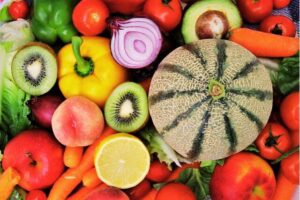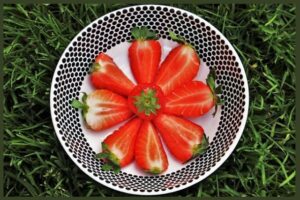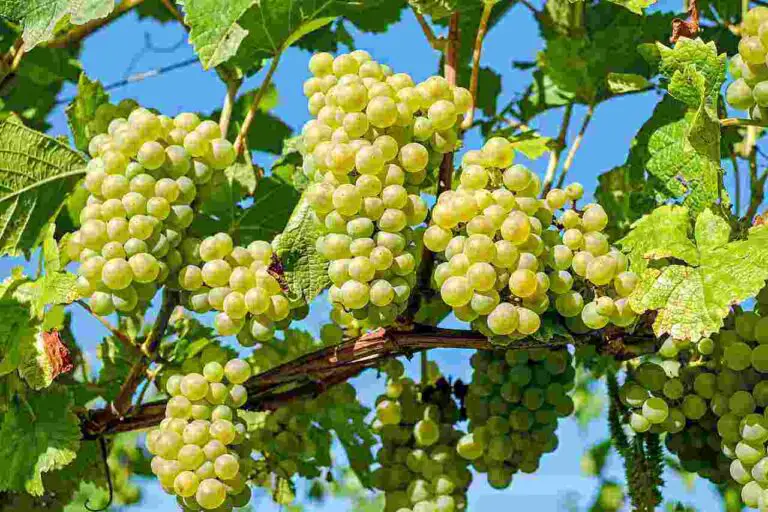Vitamins in Fruits And Vegetables

Fruits and vegetables are rich sources of essential vitamins that support overall health. They provide a wide range of vitamins, including A, C, E, and K, as well as B-complex.
Eating a diverse array of fruits and vegetables is key to ensuring you get a full spectrum of these nutrients to support bodily functions such as vision, immune response, and skin health. These foods are not only packed with vitamins but also contain minerals, fiber, and antioxidants, making them integral to a balanced diet.
Consuming a variety of colors “eating the rainbow,” as it’s commonly referred to, can help ensure you’re getting a broad range of vitamins. Integrating these vitamin-rich foods into your daily meals can contribute to sustained energy levels, improved digestion, and could potentially reduce the risk of chronic diseases. This simple dietary practice of prioritizing fruits and vegetables can make a significant difference in your overall wellbeing.
The Colors Of Nutrition
Ever wonder why fruits and vegetables are so colorful? These hues are more than just eye candy. They tell us about the healthy vitamins found inside. Let’s dive into what each color means for your health.
| Red | Rich in Vitamin C and lycopene. |
| Orange/Yellow | Full of Vitamin A and flavonoids. |
| Green | Loaded with Vitamin K, folates, and iron. |
| Blue/Purple | Has lots of antioxidants and phytonutrients. |
| White/Brown | Contains potassium and fiber. |
Selecting a rainbow of colors on your plate is key. This guarantees that you receive a variety of nutrients. Eating different colors is not only fun but also great for your body.

Essential Vitamins From Plant Sources
Fruits and vegetables are packed with vitamins necessary for good health. Many fruits are rich in vitamin C, like oranges and strawberries. Bananas offer a healthy dose of vitamin B6. Looking for vitamin A? Mangoes and peaches are great choices. Leafy greens, such as spinach, are vitamin K powerhouses.
Vegetables give our bodies lots of healthy benefits. Vitamin A is abundant in sweet potatoes and carrots. For vitamin C, eat red peppers and kale. Vegetables like broccoli and Brussels sprouts have both vitamin C and vitamin K. Ensure you eat a colorful variety to get all these vitamins!
Maximizing Vitamin Intake
To boost vitamin intake, certain tips can help. Keep fruits and vegetables fresh to save their vitamins. Store them in a cool, dry place. For most benefits, eat them as soon as possible after purchase.
Some vitamins can escape during cooking. Steam or microwave rather than boiling to keep more nutrients. Use little water and cook for a short time. This helps keep more vitamins in your food.
Cutting fruits and veggies can also expose vitamins to air. Keep them whole until you’re ready to eat or cook them. By doing this, you lock in the goodness.
Remember: Light can also affect vitamins. So, when storing them, use opaque containers. This protects the vitamins inside.
Seasonal Benefits Of Fruits And Vegetables
Eating fruits and vegetables during their peak seasons ensures optimal vitamin content. As they ripen naturally, these foods offer enhanced flavors and richer nutrient profiles. Locally-grown produce doesn’t have far to travel, keeping vitamins fresh and potent. Fall showcases vitamin-rich pumpkins and squash, while spring offers leafy greens packed with vitamins A and C.
Choosing seasonal foods not only supports your health but also the local economy. Brightly colored summer fruits like berries and melons are full of antioxidants. They help your body fight disease. The key is enjoying a variety of foods, as each carries unique vitamins and minerals.
Winter citrus fruits burst with Vitamin C, vital for a strong immune system. Remember, fresh and local equals higher nutritional value. Your body will thank you for the benefits all year round.

Superfoods: Myth Or Reality?
The concept of superfoods often sparks debate. Are they real or a myth? Let’s delve into the topic. Superfoods are not a magical cure. They don’t replace a balanced diet. However, they are nutritional and vitamin rich.
Eating varied fruits and vegetables is key to good health. Many foods deemed ‘super’ are loaded with vitamins. They boost your health more than other foods. Yet, no single food holds the key to good health. All nutrients work in synergy.
Let’s discuss vitamin absorption. Certain food pairings can help. They make it easier for your body to absorb vitamins. For instance, vitamin C aids iron absorption from plant sources. So, pairing bell peppers with spinach is a smart choice. Combining fat-soluble vitamins (A, D, E, K) with fats boosts uptake. So does adding olive oil to your salad!
Impact Of Farming Practices On Vitamin Content
Farming practices greatly affect the vitamin content in fruits and vegetables. Choosing organic methods often leads to enhanced nutrition. Studies suggest that organically grown produce may harbor more vitamins compared to conventional counterparts. One reason is the health of the soil.
Rich, nutrient-dense soil is a cornerstone of organic farming. It fosters a diverse ecosystem that helps plants to absorb more vitamins. Conversely, conventional methods focus on yield over soil wellbeing.
Overuse of chemical fertilizers degrades soil quality. Thus, it can lead to lower vitamin levels in crops. To sum up, for high vitamin content, the key lies in the soil. Healthy soil equals healthier produce, packed with vitamins.
Dietary Supplements Vs. Natural Sources
Vitamins found naturally in fruits and vegetables are vital for health, often more readily absorbed than those in dietary supplements. Harnessing the full spectrum of nutrients from fresh produce can offer benefits beyond what synthetic vitamins provide.
Can Pills Replace Plates?
Pills seem easy and quick. Fruits and vegetables contain many nutrients. Whole foods offer more than just vitamins.
Fiber and phytochemicals are in natural foods. These things are not in most pills. Your body absorbs natural nutrients better.
The Bioavailability Battle: Natural Vs. Synthetic
Bioavailability means how well your body uses a nutrient. Natural sources tend to win. Synthetic vitamins may not be as effective.
Understanding Dietary Deficiencies
Recognizing vitamin deficiencies is crucial for maintaining optimal health. Telltale signs often include fatigue, skin issues, and poor wound healing. People with low vitamin levels may notice hair loss or gum bleeding. Weak bones or frequent infections suggest a need for more vitamin D or C, respectively.
To boost vitamin intake, eat a variety of fruits and vegetables. Leafy greens are rich in vitamin K, essential for blood clotting. Citrus fruits like oranges provide a hearty dose of vitamin C, vital for immune function. Sweet potatoes and carrots, packed with vitamin A, promote good eye health. Incorporate these foods into meals for a well-rounded diet.
Building A Vitamin-rich Diet
Fruits and vegetables brim with essential vitamins crucial for a balanced diet. Integrating a variety into meals ensures nutritional adequacy. Key is diversity; no single fruit or vegetable provides all we need. The nutrient spectrum differs across color and type. Oranges offer vitamin C, carrots deliver vitamin A, and greens are rich in vitamins K and E. Aim for colorful plates to cover vitamin essentials.
Fruits and vegetables should make up half of your plate. This habit helps meet daily vitamin needs. For adults and kids alike, it’s key to eat a rainbow. Red peppers, blueberries, spinach, and yellow squash are all excellent picks. These foods contribute to health and vitality. Remember, fresh, frozen, or canned all count, so mix it up. Opt for whole fruits over juice for more fiber.
Frequently Asked Questions For Vitamins In Fruits And Vegetables
What Vitamins Do You Get From Fruits And Vegetables?
Vitamins A, C, E, and K are abundant in fruits and vegetables. They also provide a variety of B-vitamins including folate, thiamine, riboflavin, and niacin.
What Fruits And Vegetables Have The Most Vitamin A?
Sweet potatoes, carrots, and kale are high in vitamin A. Other good sources include spinach, apricots, and cantaloupe.
What Are The 13 Types Of Vitamins?
The 13 essential vitamins vital for our health are: Vitamin A, C, D, E, K, and the B vitamins: B1 (thiamine), B2 (riboflavin), B3 (niacin), B5 (pantothenic acid), B6, B7 (biotin), B9 (folate), and B12.
What Are The 3 Most Important Vitamins?
The three most important vitamins are Vitamin D for bone health, Vitamin C for immune function, and Vitamin B12 for energy production and nerve function.
Conclusion
Fruits and vegetables are nature’s vitamin vaults. Embrace the rainbow on your plate to unlock a wealth of health benefits. Eating diverse and colorful produce ensures a robust intake of essential nutrients. Let this simple habit be your stepping stone to enhanced wellness.
Start your vibrant journey to vitality today!






